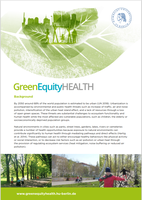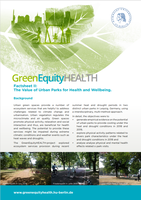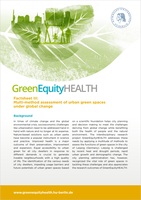GreenEquityHEALTH
Junior research group ‘Environmental-health Interactions in Cities' (GreenEquityHEALTH) – Challenges for Human Well-being under Global Changes
Leipzig - a green city responds to global changes
News
- Factsheet III: Multi-method assessment of urban green spaces under global change.
- Urban green spaces and street trees regulate the urban microclimate. In cooperation with the Helmholtz Center for Environmental Research and the Leibniz Institute for Tropospheric Research, a new methodology paper has been published here.
Recent activities
Developing a standardized tool to evaluate potentials of green spaces
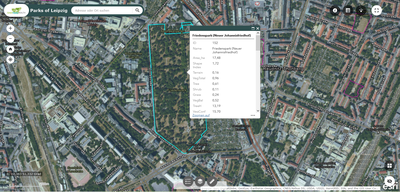
We developed a comprehensive and standardized tool that evaluates green space characteristics to support city planners and decision makers. Our interactive tool includes more than 30 indicators for green and blue structures and facility elements within green spaces but also for their spatial context, i.e., their embeddedness in the infrastructural, environmental and socioeconomic surrounding. The tool was applied to nearly 250 parks in our case study Leipzig and helps evaluating the current green space status but also identifying untapped potentials for future management and planning. The tool can be interactively explored through an online map application available at: https://arcg.is/0GXafX, or scan the following QR. See more details in Kraemer & Kabisch 2021.
Impact of summer heat on urban park visitation, perceived health and ecosystem service appreciation
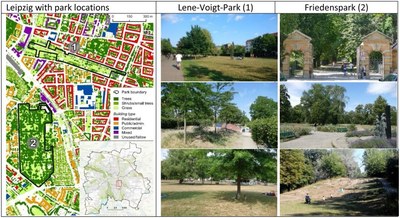
Urbanization, environmental change and ageing are putting urban health at risk. In many cities, heat stress is projected to increase. Urban green spaces are considered as an important resource to strengthen the resilience of city dwellers. We conducted a questionnaire survey in two structurally distinct parks in Leipzig, Germany, on hot summer days in 2019. We assessed the respondents’ activity patterns, satisfaction with the existing infrastructure, heat-related health impairment, changes in park use during heat waves and evaluation of the role of parks in coping with heat stress. We found that the old-grown, tree-rich park was used significantly more frequently for experiencing nature, while the newer, less tree-rich park developed on a former railway-brownfield site was used more often for socializing and having BBQs and picnics. Satisfaction with available drinking fountains and public toilets was generally low and satisfaction with lighting was assessed less satisfactory in the old-grown park. Safety was assessed as satisfactory in general but significantly less satisfactory by female respondents.
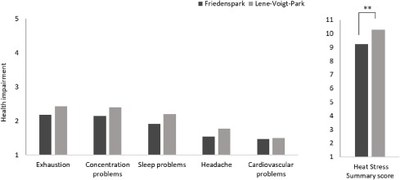
The heat stress summary score indicating heat-related health impairment was significantly higher for participants in the newer park. A high share of respondents stated that they used parks during heat waves as frequently as usual in the summer (46 %), while some respondents stated that they adapted their park use behaviour (18 %), e.g., by coming later in the evening. Regarding the participants’ responses about the role of parks under summer heat conditions, we matched 138 statements to several regulating and cultural ecosystem services, and we found cooling and recreation to be mentioned most often. We concluded that green space planning should diminish usage barriers, such as insufficient lighting and insufficient sanitary infrastructure, to ensure equal park use opportunities for all city dwellers. Specific local environmental and sociocultural conditions, changing environments and climate adaptation must be considered. To maintain ecological processes and functions and to cope with climate change, urban planning should preserve older parks with a large amount of tree coverage while respecting demands for particular built infrastructure.
Background
Urbanization can be defined as population growth and the increase in densification of built-up areas. As a global phenomenon with 66% of the global population estimated to be urban by 2050 (UN 2014), urbanization is accompanied by environmental and public health threats such as increase of traffic, air and noise pollution, intensification of the urban heat island effect, and a lack of resources through a loss of open green and blue spaces. These threats are substantial challenges to ecosystem functionality and human health while the most affected are vulnerable populations, such as children, the elderly or socioeconomically deprived population groups.
Natural environments such as urban green and blue spaces that include a number of natural components including parks, trees, gardens, lakes, rivers provide a number of health opportunities because exposure to natural environments can contribute significantly to human health through mediating pathways and direct effects (Hartig et al. 2014).
These pathways can act to either encourage healthy behaviors like physical activity or social interaction, or to decrease risk factors such as air pollution or urban heat through the provision of regulating ecosystem services (heat mitigation, noise buffering or reduced air pollution). This in turn has positive effects on human health.
The growing body of evidence about the ample environmental and health benefits that urban green and blue spaces provide focuses mostly on general populations and adults. The rare existing studies on particular vulnerable population groups such as children and the elderly shows that there is not a universal protective health effect of urban nature (Kabisch et al. 2017). Although a positive association trend is highlighted some studies remain inconclusive and context dependent.
In times of increasing urbanization and climate change the topic of urban nature is central for healthy, more resilient and sustainable urban planning, not the least for vulnerable population groups like children, the elderly or socioeconomically deprived groups that have often less access to urban green and blue spaces but are more sensitive to the health issues associated with urbanization, particularly in combination with climate change. Thus, more elaborated research is needed that take into account multiple context factors including multi-method (spatial) approaches to show impacts of global challenges on urban vegetation and vice verso on health outcomes of vulnerable urban population. As many research studies already showed, socioeconomic confounders play a major role in health outcomes and may override environmental factors. This aspect warrants the inclusion of an environmental justice perspective in future studies on the effect of urban green and blue spaces on public health in the context of urbanisation and climate change.
The research group GreenEquityHEALTH aims to assess urban environmental processes related to climate change and urbanisation with a specific focus on public health and socio-environmental justice.
Main objectives are:
1: to assess urban land‐use intensity and relate this to plant traits, to deviate potential influences of certain environmental pressure and stress from climate change and urbanisation. Pressure such as high temperatures, soil sealing, air pollution or changes and disturbances in urban vegetation patterns with potential effects on human health and well-being should be detected with remote sensing time series data and on-site sensor based measurements.
2. to conduct field surveys to measure health on site including perception studies via questionnaire surveys and health measurements. The focus is in particular on local residents including retired people and children. The aim is to assess the potential of urban green spaces for improving health of city residents. Surveys and measurements should focus on urban green spaces such as historic parks but also newly developed areas in the cities of Leipzig and Berlin.
Team
- Dr. Nadja Kabisch, Group leader
- Roland Krämer, PhD candidate
- Dagmar Wörister, Group assistant
- Camille Dammnann, Group assistant
- Oskar Masztalerz, Student assistant
- Lennart Eichfuss, Student assitant
Former employees
- Peer von Döhren
- Marion Adam
- Jan Hemmerling
- Judith Rakowski
- Miriam Brenck
Project publications
Fact sheets
Media
Video
Interactiv online map
Leipzig
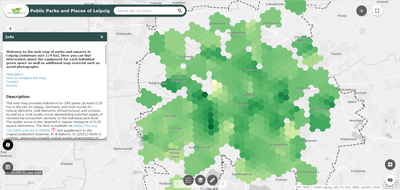
Berlin
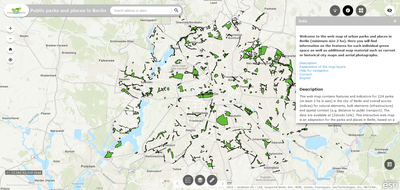
Recent publications
- Krämer, R. & Kabisch, N. (2022). Parks Under Stress: Air Temperature Regulation of Urban Green Spaces Under Conditions of Drought and Summer Heat. Frontiers in Environmental Science. 10. 10.3389/fenvs.2022.849965 .
- Zabelskyte, G. & Kabisch, N. & Stasiskiene, Z. (2022). Patterns of Urban Green Space Use Applying Social Media Data: A Systematic Literature Review. Land. 11. 238. 10.3390/land11020238.
- Kabisch, N., Krämer, R., Brenck, M., Haase, D., Lausch, A., Luttkus, M., Mueller, T., Remmler, P., Döhren, P., Voigtländer, J. & Bumberger, J. (2021). A methodological framework for the assessment of regulating and recreational ecosystem services in urban parks under heat and drought conditions. Ecosystems and People. 464-475. 10.1080/26395916.2021.1958062.
- Kabisch, N., Kraemer, R. , Masztalerz, O., Eichfuss, L., Wörister, D., Dammann, C., Brenck, M., Püffel, C., Hemmerling, J., Rakowski, J., & von Döhren, P. (2021): Junior research group 'GreenEquityHEALTH' - Factsheet III: Multi-method assessment of urban green spaces under global change. https://doi.org/10.5281/zenodo.5603610 .
- Kabisch, N., Kraemer, R., Masztalerz, O., Hemmerling, J., Püffel, C., Haase, D. (2021): Impact of summer heat on urban park visitation, perceived health and ecosystem service appreciation. Urban Forestry & Urban Greening, Vol. 60, 127058, ISSN 1618-8667. https://doi.org/10.1016/j.ufug.2021.127058 .
- Kraemer, R., Kabisch, N.(2021): Parks in context: advancing citywide spatial quality assessments of urban green spaces using fine-scaled indicators. Ecology and Society 26(2):45.https://doi.org/10.5751/ES-12485-260245 .
- Kabisch, N., Kraemer, R., Brenck, M. E., Haase, D., Lausch, A., Luttkus, M. L., Mueller, T., Remmler, P., von Döhren, P., Voigtländer, J. & Bumberger, J. (2021): A methodological framework for the assessment of regulating and recreational ecosystem services in urban parks under heat and drought conditions. Ecosystems and People, 17:1, 464-475, DOI: 10.1080/26395916.2021.1958062 .
- Kabisch, N., Püffel, C., Masztalerz, O., Hemmerling, J. & Kraemer, R. (2021): Physiological and psychological effects of visits to different urban green and street enviroments in older people: A field experiment in a dense inner-city area. Landscape and Urban Planning, Vol. 207. https://doi.org/10.1016/j.landurbplan.2020.103998 .
- Marselle, M., Hartig, T.,Cox, D., de Bell, S., Knapp, S., Lindley, S., Triguero-Mas, M., Boehning-Gaes,e K., Cook, P., de Vries, S., Heintz-Buschart, A., Hofmann M., Irvine K., Kabisch, N., Kolek, F., Kraemer, R., Markevych, I., Martens, D., Mueller, R., Nieuwenhuijsen, M., Potts, J., Stadler, J., Walton, S., Warber, S. L., Bonn, A. (2021): Pathways linking biodiversity to human health: A conceptual framework. EcoEvoRxiv. September 23. doi:10.32942/osf.io/czyv4 .
- Baró, F., Langemeyer, J., Łaszkiewicz, E., Kabisch, N., (2021): Introduction to Special Issue: advancing urban ecosystem service implementation and assessment considering different dimensions of environmental justice. Environmental Science and Policy, 15, 43-46.
Further publications can be found here.
Conference contribution
- Kabisch, N. (2017) Public health inequalities in cities – What is the role of green? At Seminar 'Global Urban Sustainability and Justice Insights, facts, visions and challenges
-
for a green-blue future of cities around the globe' at the The Royal Swedish Academy of Agriculture and Forestry (KSLA), Stockholm, Sweden.
- Kabisch, N. (2017): Session 12: Green, yes, but just? Towards more environmental and social justice in cities. GREENSURGE Final Confernce. Malmö, Sweden.
- Kabisch, N. (2017): Urban green infrastructure for sustainable urban development – The health perspective. RESILIENCE 2017 - Resilience Frontiers to Global Sustainability. Stockholm, Sweden, August 20-23, 2017.
Blog Posts
- Blog to focal points of urban ecology in The Nature of Cities: What is one thing every ecologist should know about urban ecology?
- Blog to Environmental Justice in The Nature of Cities: Ecosystems for everyone: Who should have access to the myriad benefits of ecosystem services and urban nature? Everyone. Does everyone? No. How will we achieve this moral imperative?
Advisory Board
Dagmar Haase, Humboldt-Universität zu Berlin
Matilda van den Bosch, University of British Columbia
Chantal van Ham, IUCN,
Matthias Braubach, WHO
Thomas Elmqvist, SRC
Dr. Jan Bumberger, UFZ
Angela Lausch, UFZ
Project Information
Project duration: 08/2017-07/2022
Project funder: BMBF
Funding code: 01LN1705A




